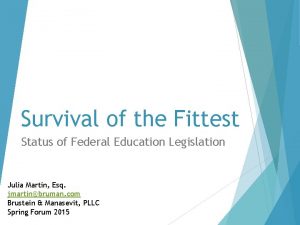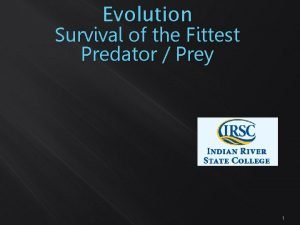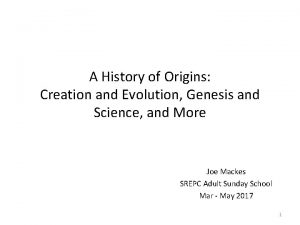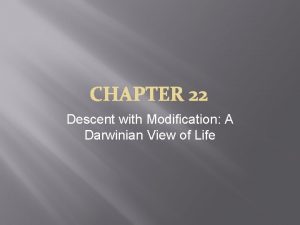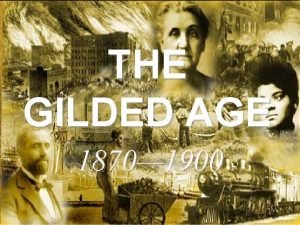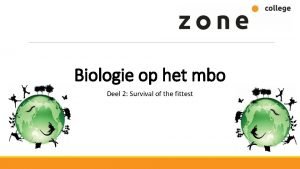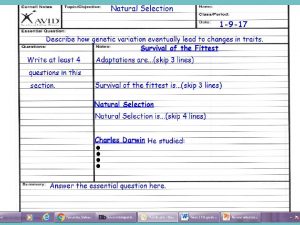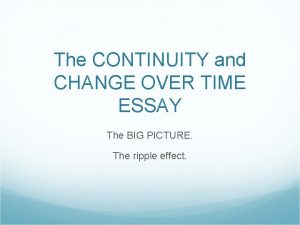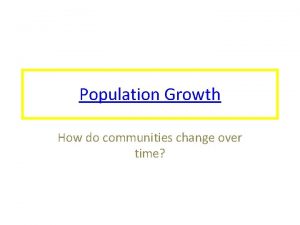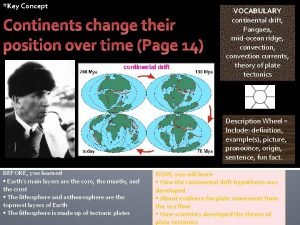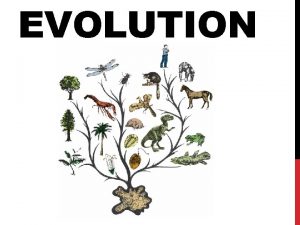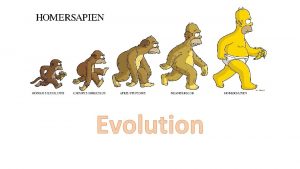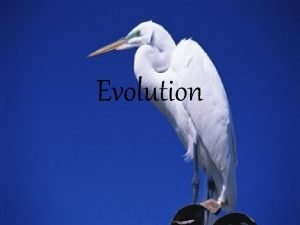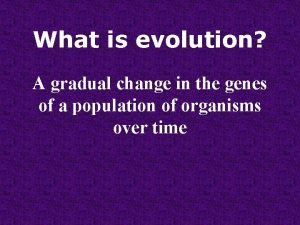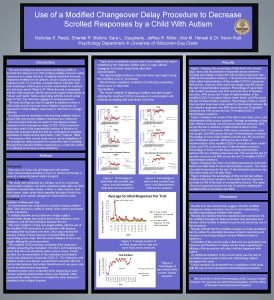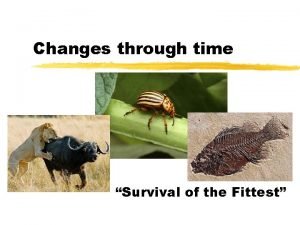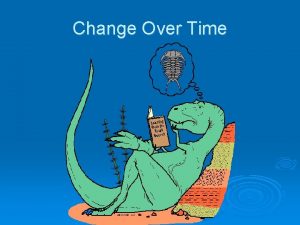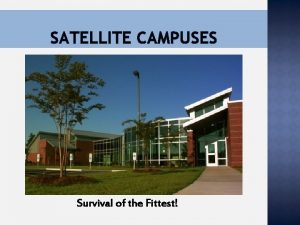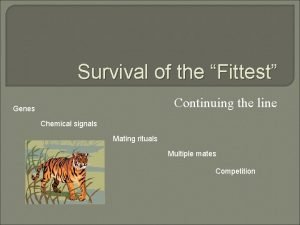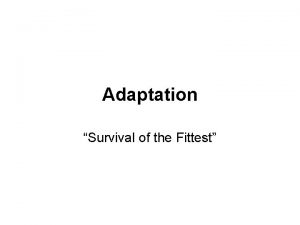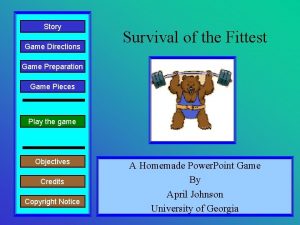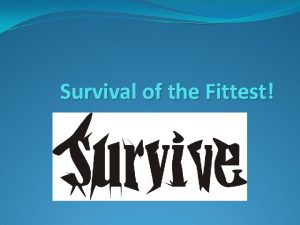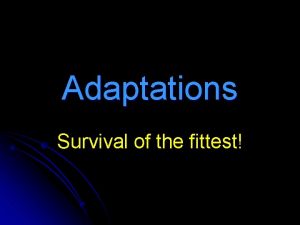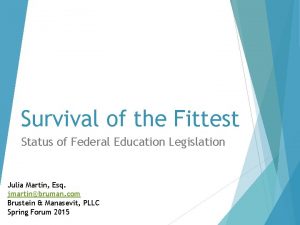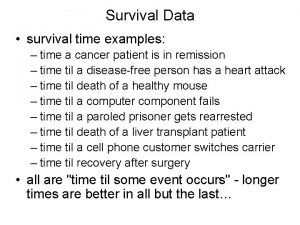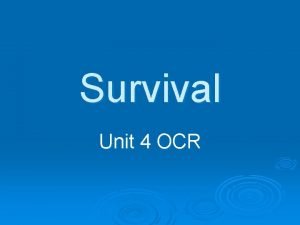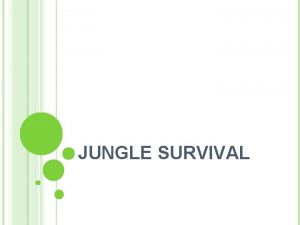Change over time Survival of the fittest How
































































- Slides: 64


“Change over time” Survival of the fittest

How did the giraffe get its long neck? Before Darwin…. . Lamark stated that organisms evolve



Lamark’s ideas: the evolution was driven by an inner “need” acquired characteristics could be passed to next generation Lamarck was rejected because his mechanism by which evolution occurred was not supported by DATA


Observation #1 offspring are produced More that can possibly survive. BUT populations tend to remain stable AND there are limited resources

SO the inference is: There is a struggle for survival between individuals of a population and not all will survive Aphaenogaster tipuna ants fighting over food

OBSERVATION #2 Organisms display a lot of variety in their characteristics Much of this variety is inherited

Inference #2: Those individuals whose inherited traits best fit them to their particular environment will leave more offspring

Inference #3: This unequal ability of individuals to survive and reproduce will cause a gradual change in the population Favorable characteristics will accumulate in the population over time

Individuals DO NOT EVOLVE. Populations evolve Evolution is not caused by a NEED of an individual. Surviving does not contribute to evolution alone. There also has to be reproduction Acquired characteristics are not passed down to the next generation. Adaptations depend on the environment




Fossils provide evidence of the change of life throughout time

Comparative Anatomy

Anatomical Homologous structures: indicators of a common ancestor Show divergent evolution


vestigial structures Structures with no or little function in organism




Embryological homologies

r a l u c e l o M s e i g o l o m o H Compare DNA sequences or proteins (amino acid sequences) The more differences the longer ago the two species diverged from a common ancestor


Analogous structures Evolved independently and don’t indicate close relationships

A) Divergent evolution results in homologous structures B) Convergent evolution results in analogous structures

Generation to generation change in the frequencies of alleles in the gene pool Causes: natural selection Genetic Drift: changes in allele frequencies due to chance Gene flow immigration or emigration of individuals (and their genes) Mutation introduces new alleles

Examples of Genetic Drift Natural disaster wipes out a portion of a population Example #2 Relatively few individuals start a new population in isolation founder effect




Peccaries are great predators of cacti = original population = population after introduction of peccaries

Parasitic wasps lay eggs at the base of the spines. Hatched larva feed on the cactus



Population or group of populations that have the potential to interbreed with each other in nature and produce viable offspring Key idea: reproductive isolation

Fig. 14 -3

Fig. 14 -3 a Habitat isolation

Fig. 14 -3 b Behavioral Isolation

Behavioral Isolation

Fig. 14 -3 c Mechanical Isolation

Fig. 14 -3 d Gametic Isolation

Fig. 14 -3 e Postzygotic Barriers Hybrids do not develop into fertile adults

National Geographic http: //www. youtube. com/watch? v=1 z. OWYj 59 BXI

Speciation is the formation of a new species Often it comes about because of some kind of geographic barrier


Adaptive radiation is a type of speciation


Phylogenetic trees


Cactus ground finch Medium ground finch Large ground finch Small Large cactus ground finch Sharp-beaked ground finch Seed eaters Cactus flower eaters Ground finches Is the medium ground finch more closely related to the small ground finch or to the large ground finch? Small tree finch Vegetarian finch Medium tree finch Large tree finch Bud eaters Woodpecker finch Mangrove finch Green warbler finch Insect eaters Tree finches Warbler finches Which finch is most closely related t the Green warbler finch?

• Beastie Activity

Brown bear Polar bear Asiatic black bear American black bear Sun bear Sloth bear Spectacled Giant panda bear Lesser Raccoon panda Miocene Pleistocene Pliocene Oligocene Ursidae Procyonidae Common ancestral carnivorans Figure 15. 12 A

THE DOMAINS OF LIFE • For several decades, scientists have classified life into five kingdoms MONERA PROTISTA PLANTAE Earliest organisms FUNGI ANIMALIA Figure 15. 14 A

• A newer system recognizes two basically distinctive groups of prokaryotes – The domain Bacteria – The domain Archaea • A third domain, the Eukarya, includes all kingdoms of eukaryotes BACTERIA ARCHAEA EUKARYA Earliest organisms Figure 15. 14 B

• Organisms are grouped into progressively larger categories (taxons) Table 15. 10

CLASSIFICATION (TAXONOMY) DOMAIN KINGDOM PHYLUM CLASS ORDER FAMILY GENUS SPECIES (SMALLEST GROUP)

NAMING OF ORGANISMS BINOMIAL NOMENCLATURE EX: Homo sapiens Pan troglodytes (chimpanzee) FIRST NAME IS GENUS NAME SECOND NAME IS SPECIES NAME

5 KINGDOMS 1) MONERA 2) PROTISTA 3) FUNGI 4) PLANTAE 5) ANIMALIA


Wiley. CDA/Cliffs. Review. Topic/Classification-Plants-Other-Organisms. to
 State of survival survival of the fittest tweak
State of survival survival of the fittest tweak State of survival survival of the fittest stages
State of survival survival of the fittest stages Evolution tree
Evolution tree Descent with modification
Descent with modification Pullman strike
Pullman strike Did von bulow believe in survival of the fittest
Did von bulow believe in survival of the fittest Verschil natuurlijke selectie en survival of the fittest
Verschil natuurlijke selectie en survival of the fittest Which type of mice are the fittest?
Which type of mice are the fittest? Continuity and change over time definition
Continuity and change over time definition How do communities change over time
How do communities change over time Continents change position over time
Continents change position over time The gradual change in a species over time
The gradual change in a species over time Semantic change
Semantic change The change in the hereditary features over time
The change in the hereditary features over time A gradual change in a community over time.
A gradual change in a community over time. The process of change over time is
The process of change over time is Change in hereditary features over time
Change in hereditary features over time Evolution is gradual
Evolution is gradual Why do classification systems change over time?
Why do classification systems change over time? For minutes. start.
For minutes. start. Over the mountain over the plains
Over the mountain over the plains Siach reciting the word over and over
Siach reciting the word over and over Explain how to handing over and taking over the watch
Explain how to handing over and taking over the watch Parallel running implementation
Parallel running implementation Change over delay
Change over delay Hình ảnh bộ gõ cơ thể búng tay
Hình ảnh bộ gõ cơ thể búng tay Slidetodoc
Slidetodoc Bổ thể
Bổ thể Tỉ lệ cơ thể trẻ em
Tỉ lệ cơ thể trẻ em Voi kéo gỗ như thế nào
Voi kéo gỗ như thế nào Tư thế worms-breton
Tư thế worms-breton Alleluia hat len nguoi oi
Alleluia hat len nguoi oi Các môn thể thao bắt đầu bằng tiếng bóng
Các môn thể thao bắt đầu bằng tiếng bóng Thế nào là hệ số cao nhất
Thế nào là hệ số cao nhất Các châu lục và đại dương trên thế giới
Các châu lục và đại dương trên thế giới Công thức tiính động năng
Công thức tiính động năng Trời xanh đây là của chúng ta thể thơ
Trời xanh đây là của chúng ta thể thơ Cách giải mật thư tọa độ
Cách giải mật thư tọa độ 101012 bằng
101012 bằng độ dài liên kết
độ dài liên kết Các châu lục và đại dương trên thế giới
Các châu lục và đại dương trên thế giới Thơ thất ngôn tứ tuyệt đường luật
Thơ thất ngôn tứ tuyệt đường luật Quá trình desamine hóa có thể tạo ra
Quá trình desamine hóa có thể tạo ra Một số thể thơ truyền thống
Một số thể thơ truyền thống Cái miệng xinh xinh thế chỉ nói điều hay thôi
Cái miệng xinh xinh thế chỉ nói điều hay thôi Vẽ hình chiếu vuông góc của vật thể sau
Vẽ hình chiếu vuông góc của vật thể sau Biện pháp chống mỏi cơ
Biện pháp chống mỏi cơ đặc điểm cơ thể của người tối cổ
đặc điểm cơ thể của người tối cổ Giọng cùng tên là
Giọng cùng tên là Vẽ hình chiếu đứng bằng cạnh của vật thể
Vẽ hình chiếu đứng bằng cạnh của vật thể Vẽ hình chiếu vuông góc của vật thể sau
Vẽ hình chiếu vuông góc của vật thể sau Thẻ vin
Thẻ vin đại từ thay thế
đại từ thay thế điện thế nghỉ
điện thế nghỉ Tư thế ngồi viết
Tư thế ngồi viết Diễn thế sinh thái là
Diễn thế sinh thái là Dot
Dot Số.nguyên tố
Số.nguyên tố Tư thế ngồi viết
Tư thế ngồi viết Lời thề hippocrates
Lời thề hippocrates Thiếu nhi thế giới liên hoan
Thiếu nhi thế giới liên hoan ưu thế lai là gì
ưu thế lai là gì Khi nào hổ con có thể sống độc lập
Khi nào hổ con có thể sống độc lập Khi nào hổ con có thể sống độc lập
Khi nào hổ con có thể sống độc lập Hệ hô hấp
Hệ hô hấp
